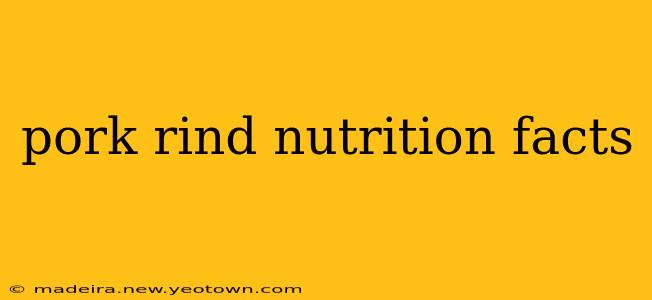Pork rinds, those crispy, salty snacks, have recently surged in popularity among those following low-carb or ketogenic diets. But are they truly a healthy choice? Let's delve into the nutritional facts of pork rinds and uncover the truth behind this crunchy treat. My journey into understanding pork rind nutrition started with a simple question: are they as good as they taste? The answer, as with most things, is nuanced.
What are the Nutritional Benefits of Pork Rinds?
The primary nutritional benefit of pork rinds lies in their high protein and low carbohydrate content. This makes them an attractive option for individuals following low-carb diets, as they can provide a satisfying crunch without significantly impacting blood sugar levels. They're also a decent source of essential amino acids, the building blocks of protein crucial for various bodily functions. Think of them as a protein-packed alternative to other less healthy snacks. My own research revealed that their protein content is surprisingly high compared to many other snacks.
Are Pork Rinds High in Fat?
Yes, pork rinds are high in fat, primarily saturated fat. This is a point often overlooked in the excitement surrounding their low carb profile. While not inherently "bad," excessive saturated fat consumption can contribute to high cholesterol levels and increased risk of heart disease. Moderation is key here. I learned that the fat content is largely dependent on the preparation method, with some brands containing more than others.
What are the Potential Downsides of Eating Pork Rinds?
Beyond the saturated fat, other potential downsides include:
-
High Sodium Content: Pork rinds are notoriously high in sodium. Excessive sodium intake can lead to water retention, high blood pressure, and other health issues. Individuals with hypertension or those watching their sodium intake should consume pork rinds sparingly.
-
Potential Allergens: Pork rinds, naturally, contain pork. Individuals with pork allergies should obviously avoid them.
-
Processing Methods: The processing of pork rinds can involve various additives, preservatives, and flavor enhancers, some of which may not be ideal for health-conscious individuals. Always check the ingredient list to see what you're consuming.
How Many Calories are in Pork Rinds?
The calorie count in pork rinds varies depending on the brand and serving size, but generally, a small serving (around 1 ounce) contains around 100-150 calories. This might seem low compared to other snacks, but remember the high fat content. Calorie counting is just one piece of the nutritional puzzle.
Are Pork Rinds Good for Weight Loss?
While pork rinds can be a part of a weight-loss strategy due to their high protein and low carb content, their high fat and sodium content needs to be considered. They can be a satisfying and filling snack, reducing cravings for higher-calorie options. However, overconsumption can negate any potential weight loss benefits. It’s not a magic bullet, it's about mindful consumption.
What are the Best Ways to Incorporate Pork Rinds into a Healthy Diet?
If you choose to include pork rinds in your diet, do so in moderation. Look for brands with lower sodium content and fewer additives. Consider them as a sometimes snack rather than a staple food. You might pair them with a small amount of healthy fat, like avocado, for satiety and balance.
Conclusion: The Pork Rind Paradox
Pork rinds present a nutritional paradox: they offer high protein and low carbohydrates, but also carry a high fat and sodium load. The key lies in moderation and mindful consumption. As with any food, understanding the nutritional profile and considering your individual health needs is crucial before incorporating them into your diet. Don't let the crunchy goodness overshadow the importance of balanced eating.

